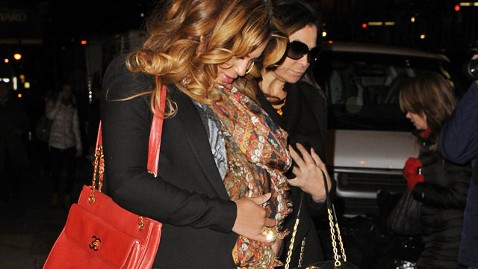Beyonce Says Birth 'Natural,' Despite Cesarean Reports

Singer Beyonce and husband Jay-Z before she gave birth to her daughter Blue Ivy. (Credit:Elder Ordonez/INF)
Royal rap couple Beyonce and Jay-Z have issued a statement that she had given birth "naturally" to daughter Blue Ivy on Jan. 7. But first reports from TMZ prompted Internet buzz over questions about whether the Cesarean birth had been planned.
Some asked: "Is natural childbirth extinct?" with C-sections at an all-time high in the United States.
Today, one in every three babies in the U.S. is born by Cesarean section - about 32.3 percent, according to the U.S. Centers for Disease Control and Prevention's Center for Health Statistics. The rate rose by 53 percent between 1996 and 2007 alone.
"Hello Hello Baby Blue," said the official statement from the couple late today. "We are happy to announce the arrival of our beautiful daughter, Blue Ivy Carter … Her birth was emotional and extremely peaceful, we are in heaven. She was delivered naturally at a healthy 7 lbs and it was the best experience of both of our lives.
Early speculation began because more women - not just those who are at high risk - are choosing to schedule a Caesarean rather than waiting for labor to begin. It is often called the "Posh push," so named for Victoria "Posh Spice" Beckham, who with her husband soccer legend David Beckham, had four children by planned C-section.
Women say a C-section is more convenient, less painful and prevents vaginal stretching. Some also opt for a tummy tuck after surgery.
The medical term for this is "delivery on maternal request," according to Dr. Vincenzo Berghella, director of maternal fetal medicine at Thomas Jefferson Hospital in Philadelphia. "It's not a new phenomenon - it's been going on for years."
Only about 10 percent of American women choose to have a Cesarean this way, and the rate is far higher in countries like Italy and Brazil, where the C-section rate is almost 90 percent of all births, according to Berghella.
"Women don't want to mess their bodies up," he said.
"Like anything else, it has possible consequences and risks," said Berghella. "If you were a 40-year-old or older woman having just one baby, having one C-section and not planning any more babies is not that unreasonable because the problem with doing a C-section just for the sake of doing it, you have a lot more risk to both the mother and baby."
It's not only expectant mothers, but doctors who favor Cesareans. In a study published in 2011 in the Journal of Obstetrics and Gynecology, said 29 percent of doctors polled said they were performing more C-sections because they feared lawsuits. Traditional births can lead to more complications than a C-section procedure.
But the trend has alarmed some medical professionals who say C-sections are more likely to cause problems that put the mother in the hospital - and the baby in intensive care.
A condition called placenta accreta, which can kill both mother and baby, is on the rise in the U.S., largely because of the increase in C-sections.
Once a rare event that affected 1 in 30,000 pregnant women in the 1950s and 1960s, placenta accreta now affects 1 in 2,500 pregnancies, according to a 2007 report in the Journal of Obstetrics and Gynecology. In some hospitals, the number is as high as 1 in 522.
A Cesarean, or any kind of surgery, including an abortion or a D & C, can destroy that layer, allowing the placenta to invade the body cavity.
"There is a chance of needing a transfusion and even losing the uterus to bleeding and much more a chance of infection and even dying of it," said Berghella.
"I am not against C-sections of there are lots of indications and a baby in distress - they are surely lifesaving for mom and often for babies," he said.